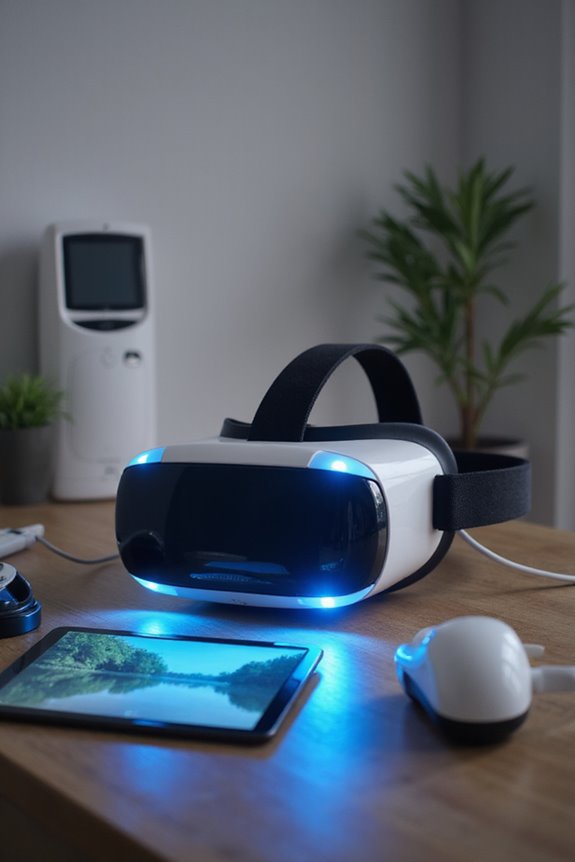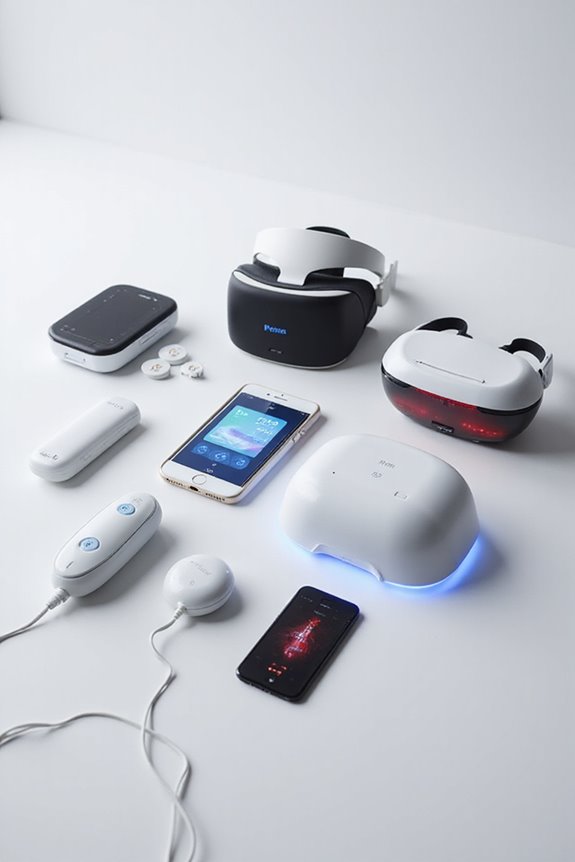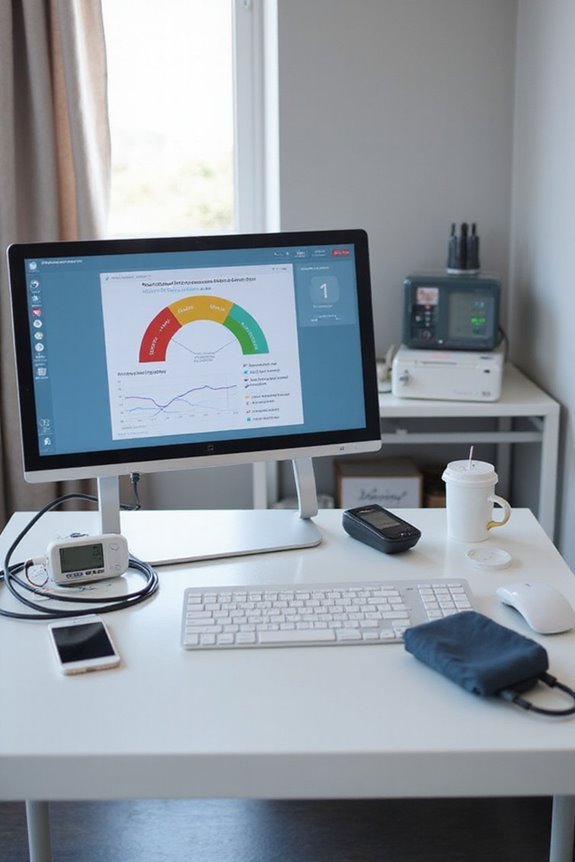Virtual Reality (VR) applications are effective in pain relief across various settings. Key points include:
- Acute pain management shows significant reduction in pain perception during procedures.
- VR devices have FDA approval for chronic low back pain, providing a non-opioid alternative.
- Mechanisms involve distraction and emotional engagement, altering brain activity related to pain perception.
- Pediatric applications reveal lower anxiety and improved cooperation in children during invasive procedures.
Further details illuminate the ongoing integration and customization in this evolving therapeutic landscape.
Key Takeaways
- VR therapy effectively reduces acute pain perception during invasive procedures by providing distraction through immersive environments.
- Prescription VR devices have been FDA authorized for chronic low back pain, offering an alternative to opioids.
- Immersive VR experiences engage cognitive resources, modifying brain pathways to alter pain perception and reduce anxiety.
- Customizable VR content can meet diverse patient needs, enhancing pain management for conditions like fibromyalgia and cancer-related pain.
- Pediatric VR applications create calming settings, significantly lowering anxiety and self-reported pain during medical procedures.
Virtual Reality in Acute Pain Management
Virtual reality (VR) has emerged as a promising adjunct in acute pain management, offering innovative approaches to enhance patient care. Evidence indicates that VR therapy effectively facilitates analgesia in various clinical settings, proving beneficial for both pain relief and procedural anxiolysis.
Key findings include:
- VR acts as a distraction, markedly reducing pain perception during invasive procedures.
- Clinical studies confirm a measurable decrease in acute pain intensity, with short VR sessions yielding considerable analgesic effects.
- Immersive environments engage cognitive resources, modulating pain processing pathways.
- Active interaction within VR enhances pain relief compared to passive experiences.
- Side effects remain low, primarily mild nausea or dizziness, supporting VR’s integration in acute pain management strategies.
Applications for Chronic Pain Relief
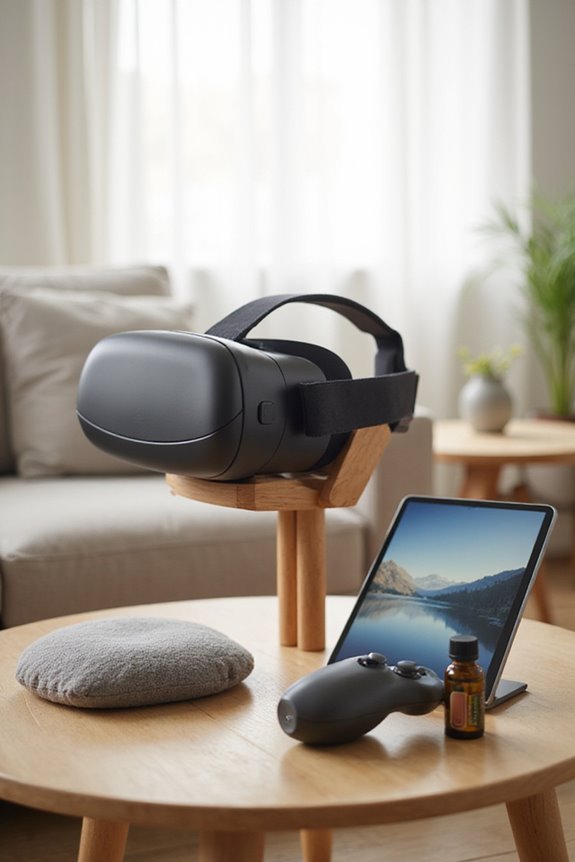
Chronic pain management faces significant challenges, prompting healthcare professionals to explore innovative solutions. Recently, the FDA authorized a prescription VR device for chronic low back pain, marking a significant advancement in therapeutic options.
Key points include:
- VR devices immerse users in calming 3D environments, helping to reduce pain perception.
- Early clinical implementations in rehabilitation hospitals gauge patient response and usability.
- VR therapy is considered as an alternative to opioids, mitigating risks associated with addiction.
- Research indicates usability among marginalized populations, though significant pain reduction remains limited.
- Ongoing customization aims to enhance VR content, ensuring it meets the diverse needs of chronic pain sufferers.
Continued research is essential to establish standardized protocols for effective implementation.
Mechanisms of VR Pain Relief
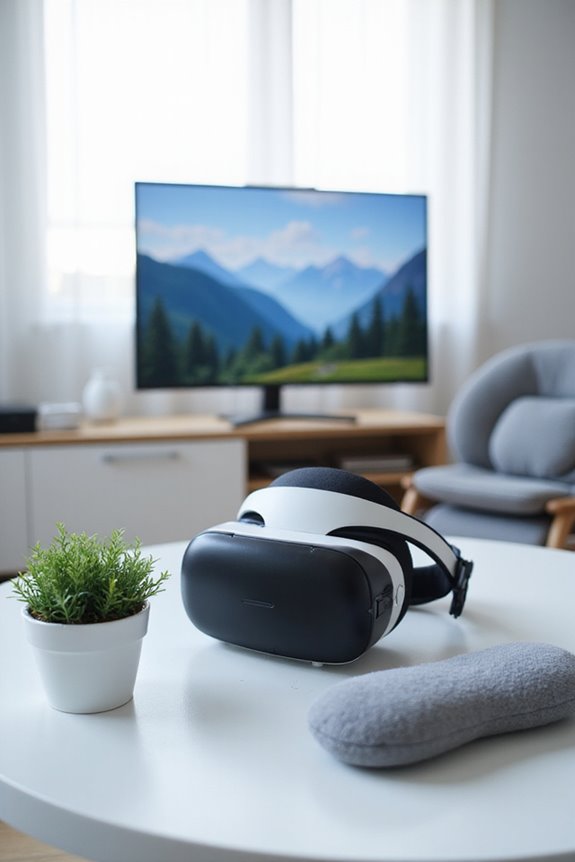
Understanding the mechanisms behind pain relief through immersive environments is essential for advancing therapeutic practices.
Distraction Techniques
- VR creates immersive experiences that divert attention from pain stimuli, effectively reducing cognitive resources for processing nociceptive signals.
- Emotional engagement in VR notably alters pain perception by modulating affective brain circuits, thereby decreasing anxiety related to pain.
Modulation of Brain Networks****
- VR impacts the pain matrix by reducing activity in cortical regions associated with pain, altering sensory processing.
- It modifies brain networks, decreasing functional connectivity between anxiety-related areas and the salience network, fostering emotional regulation.
Multisensory Input
- VR utilizes visual and auditory stimuli to compete with pain signals, recalibrating the brain’s interpretation of pain.
- This integration enhances overall pain relief effectiveness, promoting a sense of belonging and satisfaction among users.
Clinical Settings for VR Therapy

The application of virtual reality (VR) in clinical settings represents a significant advancement in pain management strategies. VR therapy integration allows healthcare providers to distract patients from acute pain during procedures, such as wound dressing changes and labor.
Key benefits include:
- Engaging patients interactively, leading to reduced subjective pain scores and improved cooperation.
- Effective management of chronic pain conditions, including fibromyalgia and cancer-related pain, through immersive experiences.
- Customizable content, such as relaxation environments and guided hypnosis, tailored to meet specific patient needs.
Despite some barriers to adoption, providers report positive experiences with VR, emphasizing its flexibility and accessibility. This technology fosters patient engagement, enhancing overall treatment experiences while offering a safe alternative to traditional pain relief methods.
Benefits of VR in Pediatric Pain Management
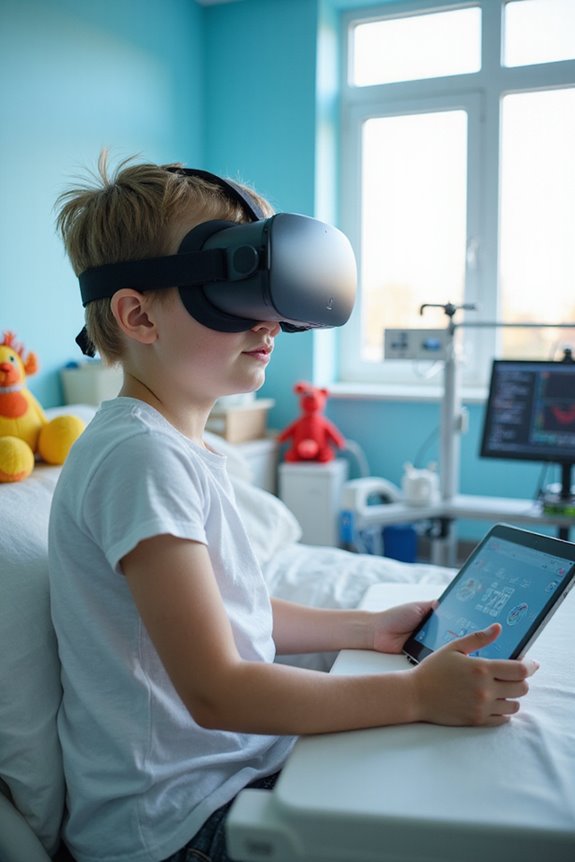
Incorporating virtual reality (VR) into pediatric pain management offers a multifaceted approach to alleviating discomfort during medical procedures.
- VR Engagement Strategies: Engaging children in immersive environments diverts their attention from painful stimuli, facilitating cognitive distraction. This involvement reduces the brain’s capacity to process pain signals.
- Pediatric Anxiety Reduction: VR creates calming settings, such as underwater scenes, effectively lowering anxiety and emotional distress.
- Clinical Findings: Randomized trials indicate that immersive VR markedly decreases self-reported pain and anxiety during procedures like venipuncture. Younger children exhibit greater benefits from VR interventions compared to older peers.
- Provider Feedback: Healthcare professionals report improved patient cooperation and reduced anxiety levels, reinforcing VR’s role as a valuable adjunct in pediatric pain management strategies.
Limitations and Challenges of VR Pain Therapy
While the potential of virtual reality (VR) in pain management is significant, several limitations and challenges hinder its widespread adoption and effectiveness.
Cost Barriers
- High initial investment for VR equipment restricts access in smaller clinics.
- Ongoing costs for specialized software further limit availability.
- Limited insurance coverage leaves patients bearing out-of-pocket expenses.
Technological Limitations
- Lack of haptic feedback reduces immersion and therapeutic potential.
- Motion sickness and eye strain may deter patient adherence.
Patient Suitability
- Certain cognitive or physical impairments can limit candidate suitability.
- Uncertainty in patient acceptance and engagement remains a concern.
Integration Challenges
- Complex logistics hinder incorporation into existing workflows.
- Collaboration among healthcare professionals is essential for effective implementation.
Research Gaps
– Insufficient evidence on the long-term efficacy of VR therapy persists.
Evidence Supporting VR for Pain Management
Evidence supporting the efficacy of virtual reality (VR) in pain management is emerging through a variety of clinical trials and studies.
- Randomized controlled trials indicate significant reductions in both acute and chronic pain.
- The FDA-approved device RelieVRx demonstrated over 46% of users experiencing more than 50% pain reduction after eight weeks.
- A pilot study reported a 75.8% pain intensity reduction after 15-minute VR sessions, with statistical significance (p < 0.05).
- Larger studies consistently show pain decreases ranging from p < 0.05 to p < 0.001.
VR technology integration enhances user experience, providing immersive distraction and inducing relaxation, as evidenced by heart rate reductions during sessions. These findings highlight VR’s potential as a non-pharmacologic adjunct in pain management strategies.
Frequently Asked Questions
What Types of VR Equipment Are Typically Used in Pain Management?
In the domain of pain management, VR technology acts like a portal, transporting individuals into immersive experiences. Equipment ranges from head-mounted displays to tactile controllers, fostering engagement and distraction to alleviate discomfort in various settings.
How Long Does a Typical VR Session Last for Pain Relief?
Session duration for pain management typically ranges from 2 to 40 minutes, varying based on pain type and treatment goals. Shorter sessions offer immediate relief, while longer sessions support ongoing management for chronic conditions.
Can VR Be Used Alongside Traditional Pain Medications?
Research indicates that VR can effectively complement traditional pain medications, fostering medication synergy. Pain management integration through VR offers a promising avenue for enhancing patient outcomes, emphasizing the importance of personalized treatment approaches in modern healthcare settings.
Are There Age Restrictions for Using VR in Pain Therapy?
Age considerations in VR therapy guidelines emphasize individualized assessments rather than strict age restrictions. While pediatric use is feasible under supervision, safety concerns necessitate careful monitoring, particularly for younger patients susceptible to discomfort during sessions.
How Is Patient Engagement in VR Therapy Measured?
In an age where technology reigns supreme, patient engagement in VR therapy is measured through engagement metrics and patient feedback, encompassing quantitative data, qualitative insights, and behavioral indicators to assess overall therapeutic involvement and satisfaction.

